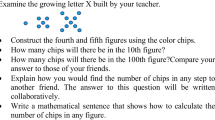Abstract
The overwhelming presence of a procedural meaning of equality and equations reported in previous research has led to a call for suitable pedagogical interventions to nurture a relational meaning of these concepts. This paper is a response to that call. Drawing on the theory of objectification, the first part deals with the configuration of a Grade 3 (8–9-year-old students) teaching–learning activity that seeks to create the classroom conditions for the formation of the mathematical operations and operation-based rules that underpin the algebraic simplification of linear equations. Instead of using problems involving abstract open arithmetic sentences or alphanumeric equations (e.g., \(5 + \_\_\) = 16; \(2n + 3 = 11\)), the teaching–learning activity resorts to story-problems. Two visual semiotic systems serving to model and solve the story-problems were devised. The story-problems were framed in narratives that allowed the teacher and the students to infuse equations, their equating parts, and the mathematical operations with contextual meanings. The first part of the paper includes the theoretical assumptions about the teaching–learning activity and its configuration, and a rationale behind the devisal of the semiotic systems. The second part presents a Vygotskian multimodal genetic analysis of the teaching–learning activity; that is, an analysis that shows the formation of concepts in motion, in the process of their genesis. The genetic analysis sheds some light on the way students, in their work with the teacher, encountered and refined the cultural-historical algebraic meanings of the equal sign and equations, and the concepts required in solving equations.









Similar content being viewed by others
Notes
The tenth century mathematician Ikhwan al-Ṣafā’ wrote, “So I say that the product of the ten by seven is equal to (musāwin) the product of seven by itself and three by seven” (Oaks, 2010, p. 267).
A story-problem is a sub-category of the category of word-problems. The difference is that a story-problem includes an experiential context and a narrative in which agents participate in some way or another. As described in the following sections, our story-problems include children (agents) having and/or receiving things (narrative) such as candies or cards (experiential context). A problem like “Divide 10 into two parts such that the division of one by the other gives 4” is a word-problem, not a story-problem.
Our CSS is not far from balance models used sometimes in research and instruction (see, e.g., Blanton et al., 2018; Stephens et al., 2022; Vlassis, 2002; for a review, see Otten et al., 2020). In our case, the balance is replaced by story-problems that, through narratives, bring to life the equality of the equating parts.
The first contact with equations in Grade 2 was described by Radford (2017).
Figures are numbered from left to right and top to bottom. In Fig. 1 they are numbered as 1.1, 1.2, 1.3, 1.4.
The six problems discussed in this paper constituted the task and were chosen following the theoretical guidelines of our approach to task design. One distinctive idea of task design in the theory of objectification is that the problems of the task follow “an organization... according to an increasing conceptual complexity” (Radford, 2021, p. 134). Simpler problems come first (e.g., x + 2 = 8), complex problems come later (e.g., 3x + 1 = 5 + x), while what is learned in one problem is put in the service of solving the next problems.
For an interesting discussion of equality and similarity in Greek mathematics, see the account by Fried (2009).
References
Asghari, A. (2019). Equivalence: An attempt at a history of the idea. Synthese, 196, 4657–4677. https://doi.org/10.1007/s11229-018-1674-2
Bajwa, N., & Perry, M. (2021). Features of a pan balance that may support students’ developing understanding of mathematical equivalence. Mathematical Thinking and Learning, 21(1), 1–27. https://doi.org/10.1080/10986065.2020.1700587
Baldwin, J. M. (1911). The individual and society, or psychology and sociology. Gorham Press.
Blanton, M., Otálora, Y., Brizuela, B., Gardiner, A., Sawrey, K., Gibbins, A., & Kim, Y. (2018). Exploring kindergarten students’ early understandings of the equal sign. Mathematical Thinking and Learning, 20(3), 167–201. https://doi.org/10.1080/10986065.2018.1474534
Bruner, J. (1990). Acts of meaning. Harvard University Press.
Cajori, F. (1993). A history of mathematical notations. Dover.
Carpenter, T., Franke, M., & Levi, L. (2003). Thinking mathematically. Heinemann.
Filloy, E., & Rojano, T. (1989). Solving equations: The transition from arithmetic to algebra. For the Learning of Mathematics, 9(2), 19–25.
Franci, R., & Rigatelli, L. T. (1988). Fourteenth-century Italian algebra. In Mathematics from manuscript to print. 1300–1600 (pp. 11–29). Clarendon Press.
Fried, M. (2009). Similarity and equality in Greek mathematics: Semiotics, history of mathematics, and mathematics education. For the Learning of Mathematics, 29(1), 2–7.
Jones, I., Inglis, M., Gilmore, C., & Dowens, M. (2012). Substitution and sameness: Two components of a relational conception of the equals sign. Journal of Experimental Child Psychology, 113, 166–176. https://doi.org/10.1016/j.jecp.2012.05.003
Kanu, Y. (2003). Curriculum as cultural practice: Postcolonial imagination. Journal of the Canadian Association for Curriculum Studies, 1(1), 67–81. https://jcacs.journals.yorku.ca/index.php/jcacs/article/view/16851.
Kieran, C. (1981). Concepts associated with the equality symbol. Educational Studies in Mathematics, 12(3), 317–326.
Knuth, E., Stephens, A., McNeil, N., & Alibali, M. (2006). Does understanding the equal sign matter? Evidence from solving equations. Journal for Research in Mathematics Education, 37(4), 297–312.
Matthews, P., & Rittle-Johnson, B. (2009). In pursuit of knowledge: Comparing self-explanations, concepts, and procedures as pedagogical tools. Journal of Experimental Child Psychology, 104, 1–21.
Mazur, B. (2008). When is one thing equal to some other thing? In B. Gold & R. A. Simons (Eds.), Proof and other dilemmas (pp. 221–241). MAA Spectrum.
McNeil, N., Grandau, L., Knuth, E., Alibali, M., Stephens, A., Hattikudur, S., & Krill, D. (2006). Middle-school students’ understanding of the equal sign: The books they read can’t help. Cognition and Instruction, 24(3), 367–385.
Mikhailov, F. T. (1980). The riddle of the self. Progress Publishers.
Oaks, J. (2010). Equations and equating in Arabic mathematics. Archives Internationales D’histoire Des Sciences, 60(165), 265–298.
Oaks, J., & Alkhateeb, H. (2007). Simplifying equations in Arabic algebra. Historia Mathematica, 34, 45–61. https://doi.org/10.1016/j.hm.2006.02.006
Otte, M., & de Barros, L. (2013). A=B. Uma visão Peirceana [A=B from a Peircean viewpoint]. In J. Queiroz & L. de Moraes (Eds.), A lógica de diagramas de Charles Peirce (pp. 171–205). Editora UFJF.
Otten, M., Van den Heuvel-Panhuizen, M., Veldhuis, M., Boom, J., & Heinze, A. (2020). Are physical experiences with the balance model beneficial for students’ algebraic reasoning? Education Science, 10, 163. https://doi.org/10.3390/educsci10060163
Radford, L. (2014). Towards an embodied, cultural, and material conception of mathematics cognition. ZDM—the International Journal on Mathematics Education, 46, 349–361.
Radford, L. (2015). Methodological aspects of the theory of objectification. Perspectivas Da Educação Matemática, 8, 547–567.
Radford, L. (2017). La fenomenología del significado [The phenomenology of signifying]. In M. J. Costa dos Santos & F. Vieira Alves (Eds.), Docência, cognição e aprendizagem: Contextos diversos (pp. 15–29). Editora CRV.
Radford, L. (2021). The theory of objectification. A Vygotskian perspective on knowing and becoming in mathematics teaching and learning. Brill/Sense.
Radford, L., & Sabena, C. (2015). The question of method in a Vygotskian semiotic approach. In A. Bikner-Ahsbahs, C. Knipping, & N. Presmeg (Eds.), Approaches to qualitative research in mathematics education (pp. 157–182). Springer.
Rittle-Johnson, B., Matthews, P., & Taylor, R. (2011). Assessing knowledge of mathematical equivalence: A construct-modeling approach. Journal of Educational Psychology, 103(1), 85–104. https://doi.org/10.1037/a0021334
Schwarzkopf, R., Nührenbörger, M., & Mayer, C. (2018). Algebraic understanding of equalities in primary classes. In C. Kieran (Ed.), Teaching and learning algebraic thinking with 5- to 12-year-olds (pp. 195–212). Springer. https://doi.org/10.1007/978-3-319-68351-5_8
Stephens, A., Knuth, E., Blanton, M., Isler, I., Gardiner, A., & Marum, T. (2013). Equation structure and the meaning of the equal sign: The impact of task selection in eliciting elementary students’ understandings. Journal of Mathematical Behavior, 32, 173–182. https://doi.org/10.1016/j.jmathb.2013.02.001
Stephens, A., Sung, Y., Strachota, S., Torres, R., Morton, K., Gardiner, A., Blanton, M., Knuth, E., & Stroud, R. (2022). The role of balance scales in supporting productive thinking about equations among diverse learners. Mathematical Thinking and Learning, 24(1), 1–18. https://doi.org/10.1080/10986065.2020.1793055
Vlassis, J. (2002). The balance model: Hindrance or support for the solving of linear equations with one unknown. Educational Studies in Mathematics, 49(2), 341–359.
Vygotsky, L. S. (1987). Collected works (Vol. 1). Plenum.
Vygotsky, L. S. (1993). Collected works (Vol. 2). Plenum.
Vygotsky, L. S. (1997). Collected works (Vol. 4). Plenum.
Acknowledgements
This paper is a result of a research program funded by the Social Sciences and Humanities Research Council of Canada. I am grateful to the reviewers and editors for their comments and critique.
Author information
Authors and Affiliations
Corresponding author
Additional information
Publisher's Note
Springer Nature remains neutral with regard to jurisdictional claims in published maps and institutional affiliations.
Rights and permissions
Springer Nature or its licensor holds exclusive rights to this article under a publishing agreement with the author(s) or other rightsholder(s); author self-archiving of the accepted manuscript version of this article is solely governed by the terms of such publishing agreement and applicable law.
About this article
Cite this article
Radford, L. Introducing equations in early algebra. ZDM Mathematics Education 54, 1151–1167 (2022). https://doi.org/10.1007/s11858-022-01422-x
Accepted:
Published:
Issue Date:
DOI: https://doi.org/10.1007/s11858-022-01422-x




